Three days ago I photographed a strange and intriguing Wilson’s Snipe behavior and the next day I posted a single photo of it, with little explanation because I didn’t understand why they were doing it. After a little research I can now at least take an educated guess as to their motivation.
I photographed the behavior five times. In two of those times my photos were very soft, in one case because I never got the bird in focus and in the other because I obtained focus but quickly lost it. In the other three instances, the behavior may or may not have been performed by the same bird – the same bird out of at least 200 snipes. Below are my photos documenting the three instances where my photos were sharp, or sharp enough.
In this species, sexes are similar in plumage. Females have longer bills and shorter outer retrices than males but those are judgment calls I’m hesitant to make. So in all cases, as a matter of convenience, I’ll refer to these birds as males, even though I don’t really know their sex.
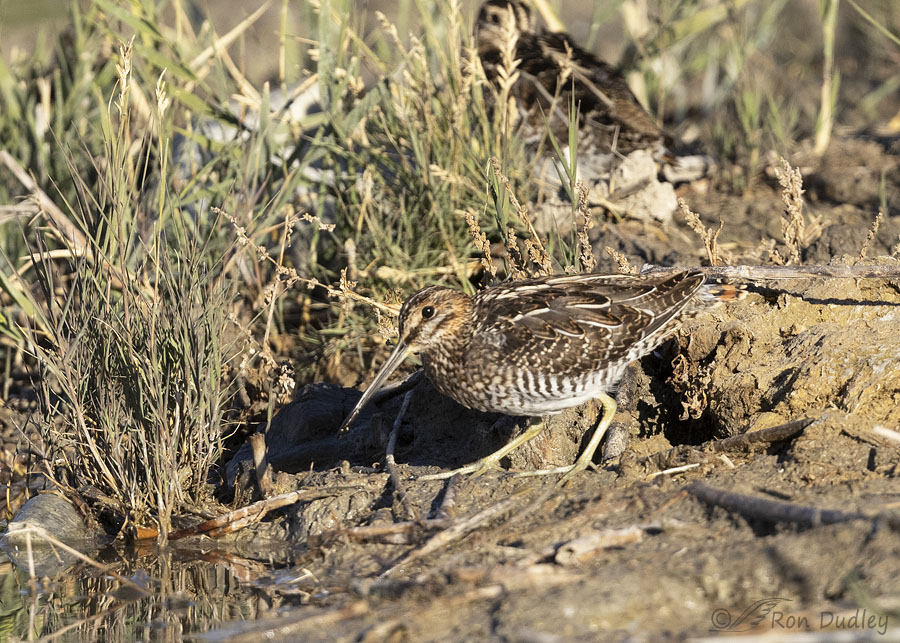
This bird wasn’t close but I had a good look at the behavior. He was hanging out at the shore and looking in the direction (west) from which other snipes nearly always approached this spot when they were coming in to land and join all the snipes on the ground.
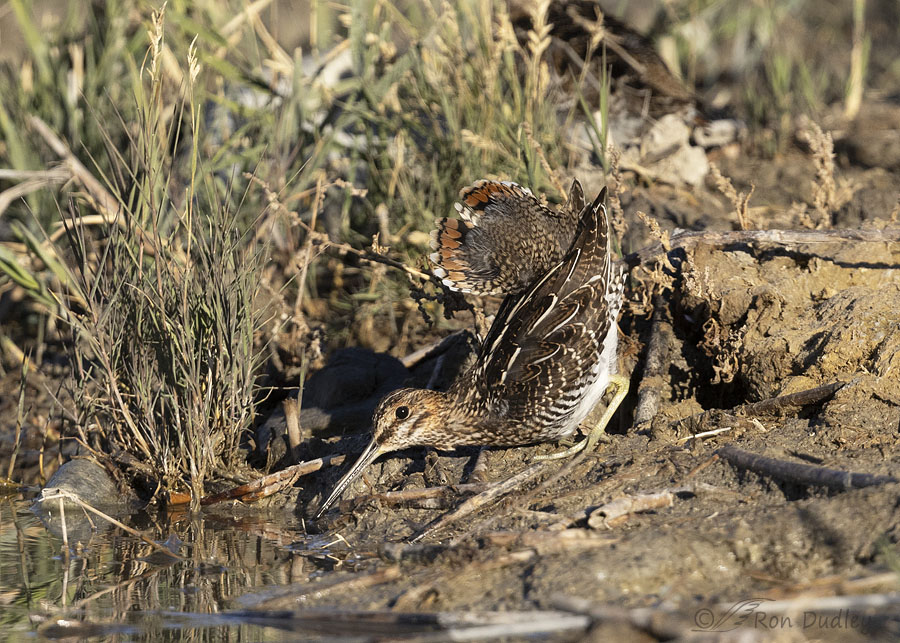
Suddenly he crouched down, fanned his tail and cocked it vertically and sideways. He held this position for long enough for me to get eight almost identical photos of it. I’d never before seen anything quite like it, from any species.
This is the same photo I posted three days ago.
Because he was facing incoming snipes when he did it, and because of research I did that suggests as much (I’ll refer to that research below), I now believe it was an agonistic (aggressive) display directed at the incoming birds.
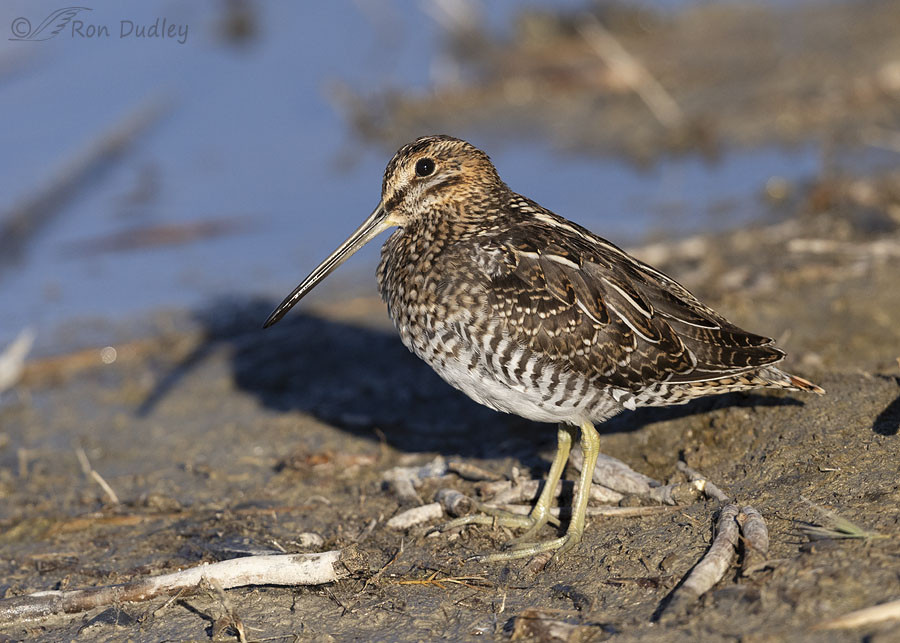
Less than a minute later I focused on this bird that was much closer to me than the previous one. He was also near the shore and looking in the general direction that incoming snipes nearly always approached from.
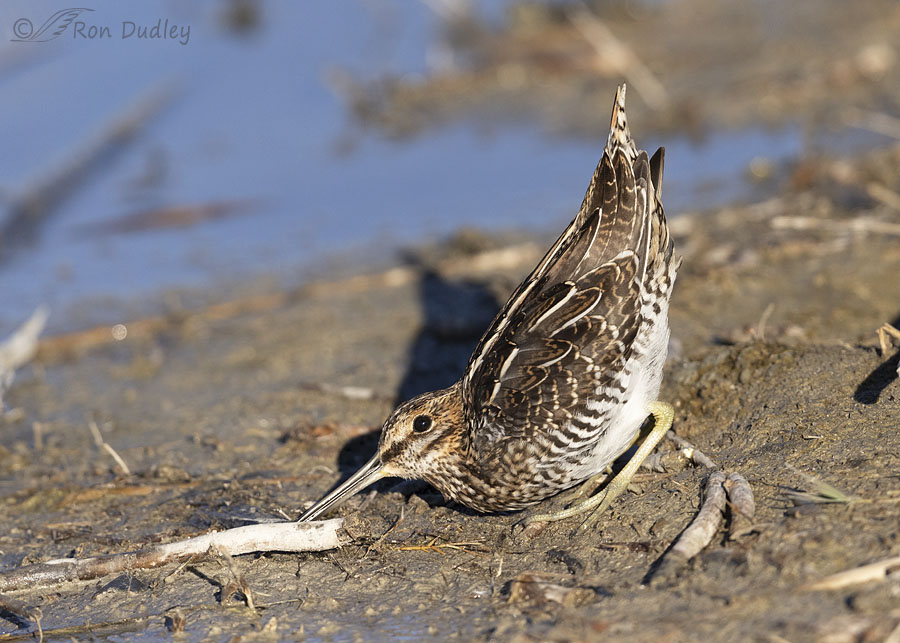
Suddenly he did the same thing, or at least tried to. He crouched down and…
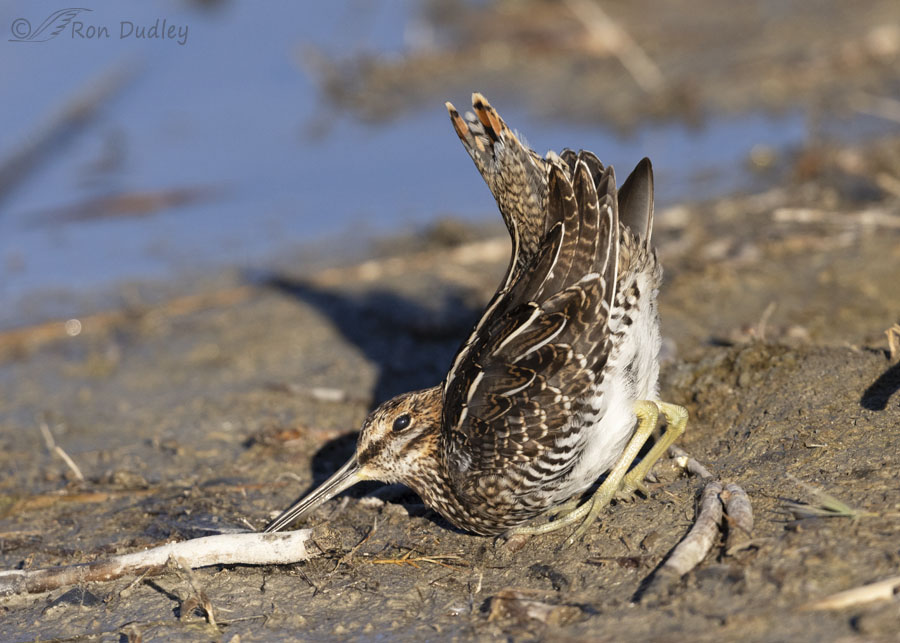
began to raise and…
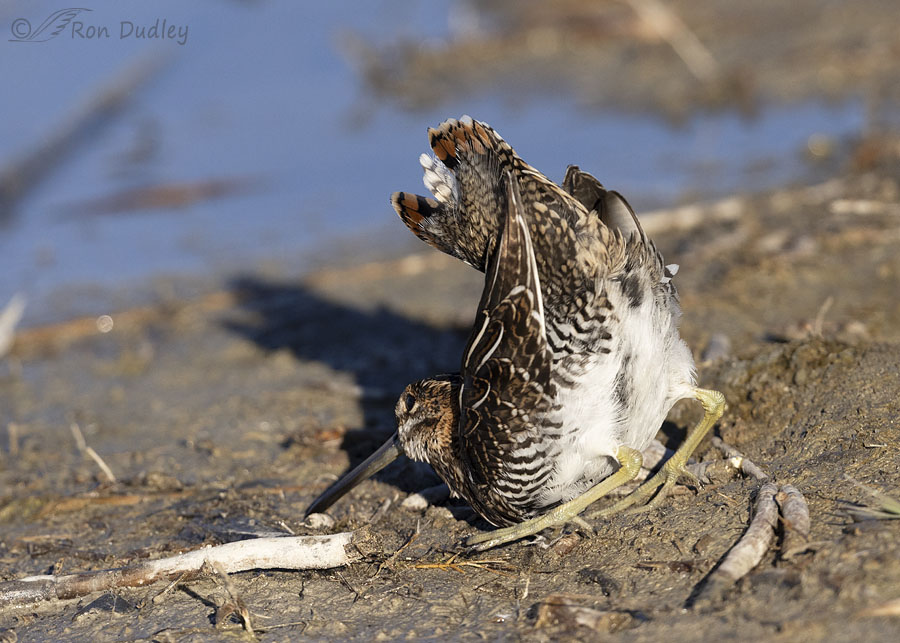
fan his tail. But the incoming snipes must have been coming in slightly to his right because he began to turn his body in that direction so he could continue to face them.
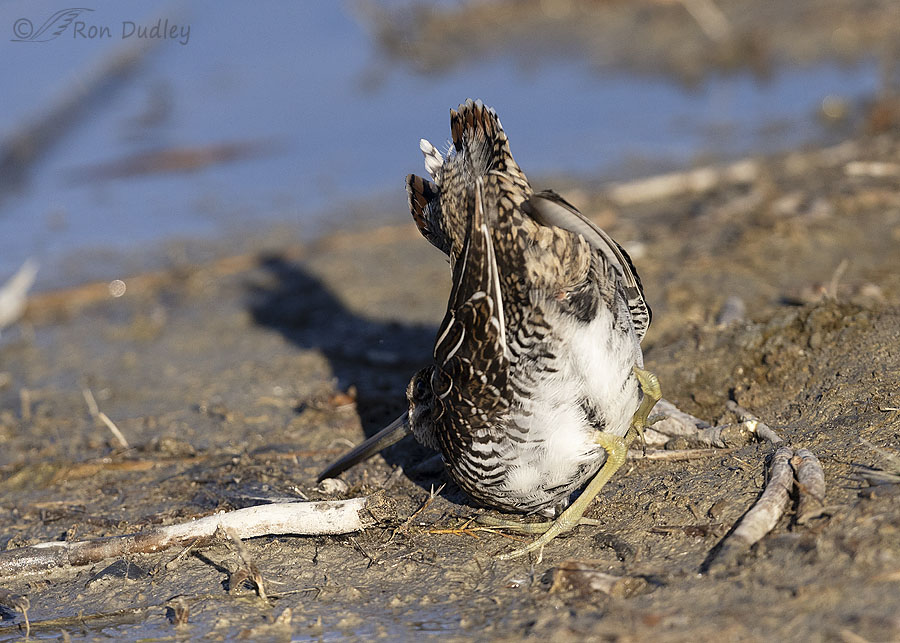
Because the tip of his bill was dragging on the ground as he turned (possibly getting caught on that little white rock) it almost upset the apple cart.
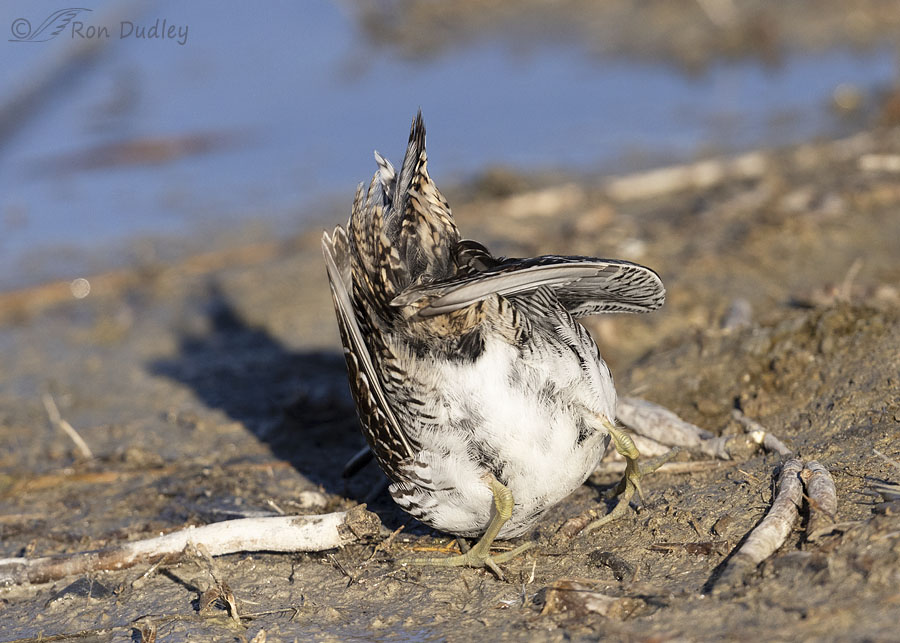
He very nearly toppled over on his left side.
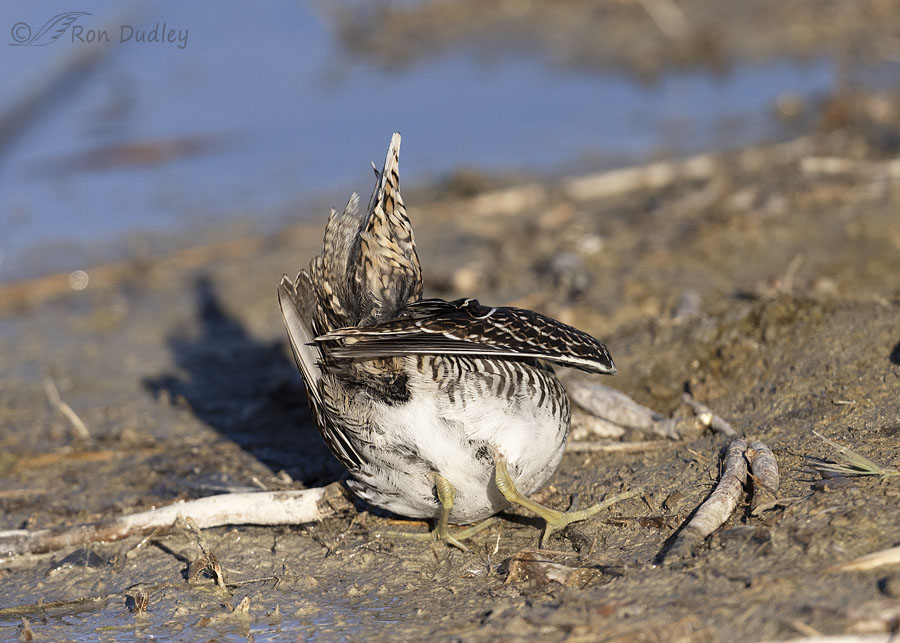
I don’t like to laugh out loud at the expense of birds I’m photographing but this time I couldn’t help myself.
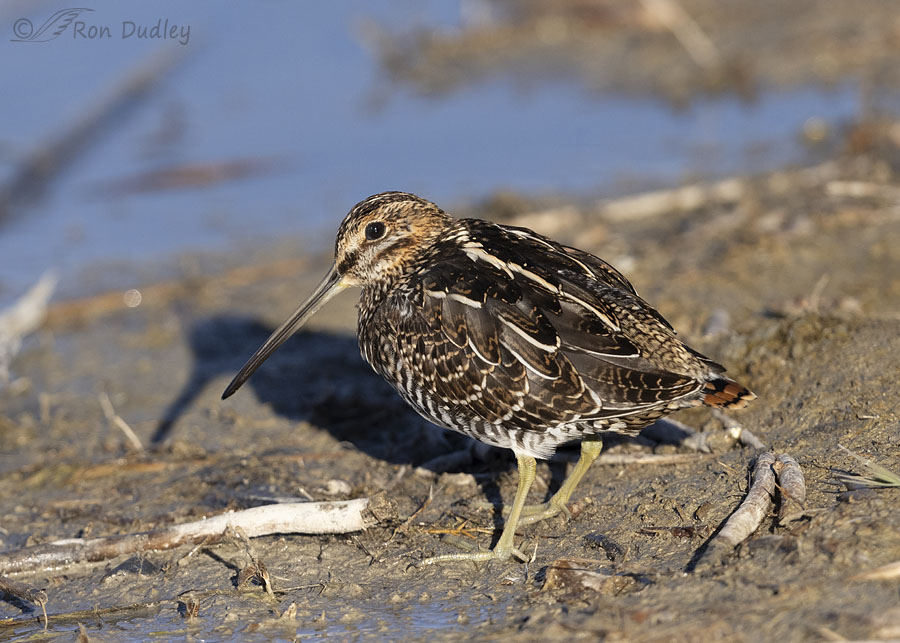
But he recovered nicely and returned to his station to watch for more incoming snipes.
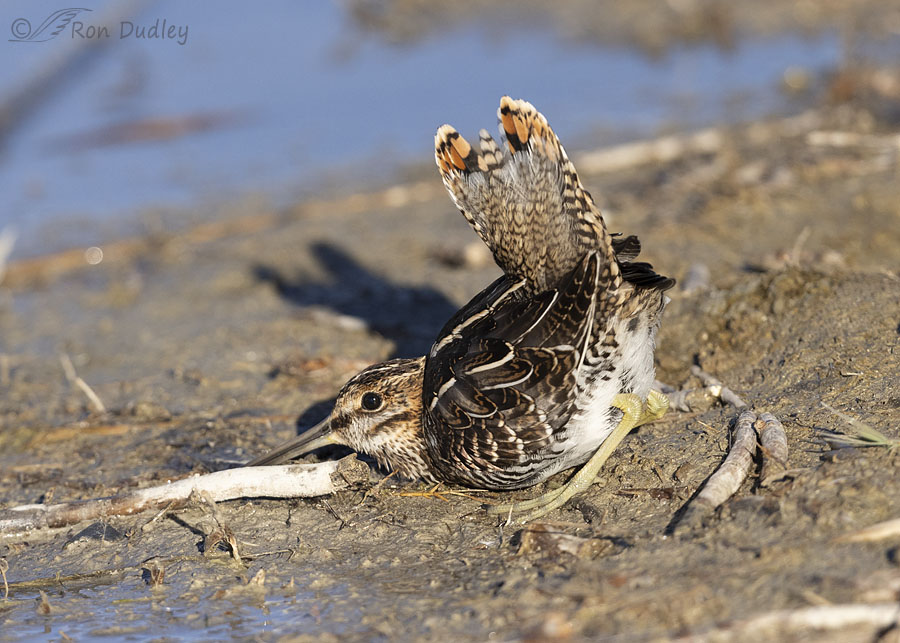
Only seconds later he did it again. He crouched down, cocked his tail and…
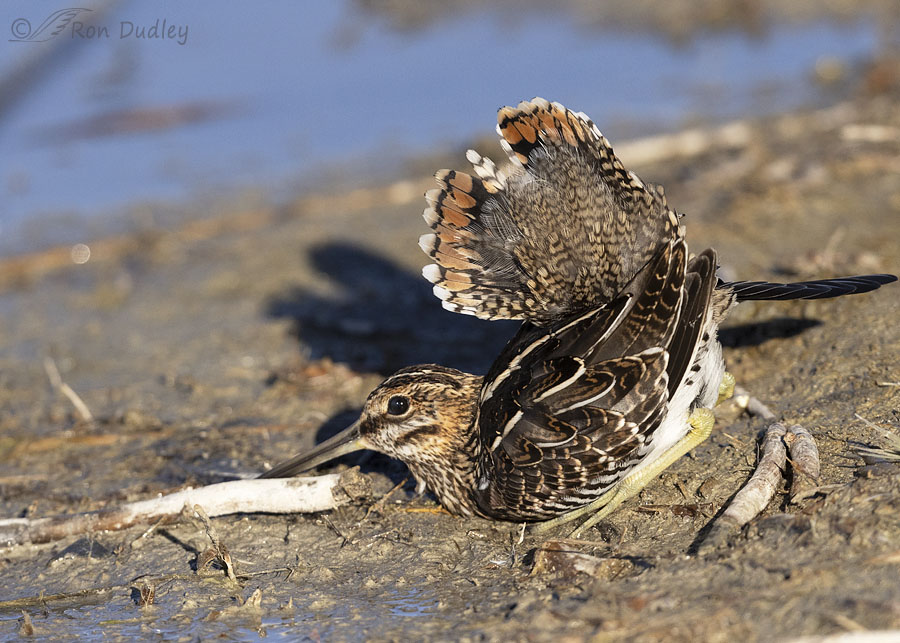
fanned it to one side. He held this pose for long enough for me to get 20 photos very similar to this one. But unlike the previous instances, this time he…
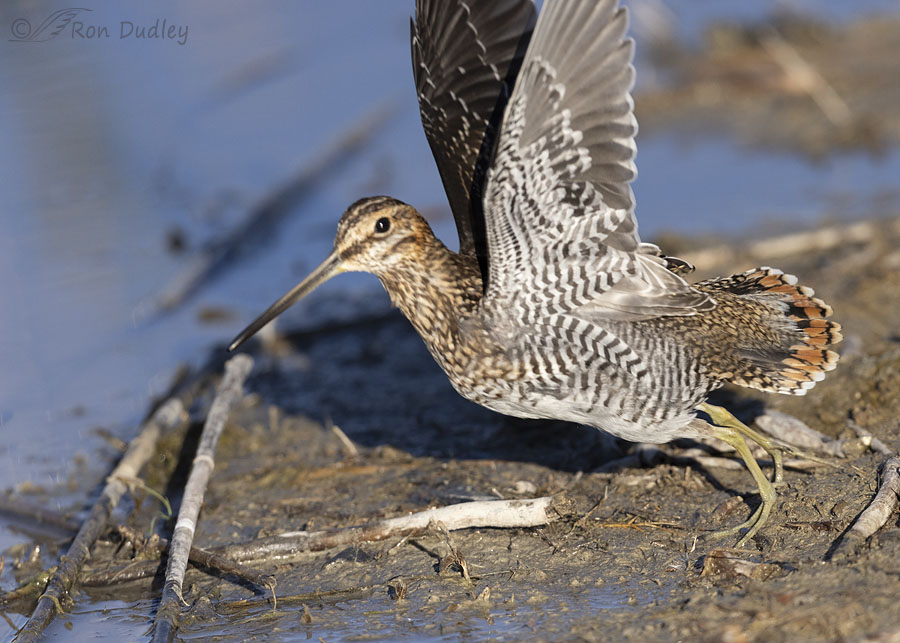
sprang up and took off. I can only guess why.
I spent some time attempting to research this behavior and found four instances in Cornell’s Birds of the World of snipe behavior somewhat similar to what I observed in the field. I say “similar” because all of them are associated with aggressive interactions between Wilson’s Snipes that involve crouching, vertical tail cocking and/or tail fanning but none of them are exactly like what I saw.
- “Fighting – Meet breast to breast, with tail cocked vertically and fully fanned; fence with bills.”
- “Flutter Leap – Suddenly crouches with fully fanned tail cocked forward, head lowered so that beak is parallel to and touching” ground, and then springs into air. Shown in agonistic encounters when feeding in winter and during spring and fall migration, and sometimes preceding copulation.
- “Sparring. Body and bill horizontal; tail fanned and cocked vertically. Display restricted to between males on breeding ground competing for a female, but also occurs on wintering area when birds are crowded densely while feeding.”
- “Displacement-Feeding – Holds bill rigidly downward and tail erect and fanned.”
So, have I proven that the behaviors I documented were aggressive displays directed toward incoming snipes? Nope, I haven’t. But I’d say it’s pretty good evidence to support such a conclusion.
Ron
Note:
Sharp eyes may have noticed that both birds in today’s post show a new, white, shorter feather growing in on the same position on their tails (see photos #2 and #12). So, are they the same bird? Your guess is as good as mine. I see reason to believe that they are the same bird and that they aren’t.


I’m late to the party, but just had to say that this was a fascinating post with a lot of great pictures to back it up. Thanks Ron.
Always great to see great photos documenting bird behavior. You have always been a specialist at that.
I am glad you got some photos of the behavior. I watched the tail display both times I have been watching them. I have not been able to get clean photos, I have some of the fanned tail but my camera always looses focus. I also watched many doing a flutter hop both close up and across the pond. I got a reasonably good shot of one in mid hop. I still have not processed many of mine. I have been busy with others things.
April, I read about the flutter hop but have no photos of it. I’m not sure I’ve even seen it.
Thank you. My far from educated best guess had assumed a similar reason, but it is nice (very nice) to learn that with much more evidence and experience you agree with me.
And you are most definitely both an educator and an artist. Says the very adult women who sticks her tongue out at you for disagreeing with me and and the others who agree.
“And you are most definitely… an artist.”
I’m glad you think so, EC. But I know some bonafide artists and my skills in that department don’t hold a candle to theirs.
But you my friend, can stick your tongue out at me anytime…
Well documented curious behavior.
So, in effect, flipping them ‘the bird’? 😜
Something like that, Michael. Thanks.
That was a great, and educational, fun series Ron but the part I liked best was the quip “maybe that’s how snipes got their name”. Very interesting behaviour. Oh, and since this is the first time I have had leisure since you announced the decline in bird numbers and frequency of postings, this is just to say that I will be here as long as you are. Your not just about pretty pics. Your posts are worth the wait. 😉
Thanks for your confidence in the value of my posts, Granny Pat. I’m still thinking I’ll be taking days off now and then but hopefully it won’t be too often.
Hummingbirds often “flash” their tail feathers as what seems to be a “dominance” behavior when defending a feeder.
Yup.
Absolutely brilliant photo series and observations, Ron. You are a national treasure. I do believe, however, that I heard the affronted tipping bird sniping at you for your laughter. Thanks, as always!
“I do believe, however, that I heard the affronted tipping bird sniping at you for your laughter.”
Made me smile, Nanci. Maybe that’s how snipes got their name… 🙂
Perhaps, shadow boxing. I could not agree more with Everett’s comment. I see you as an artist and an educator.
Thank You and Take Care,
Kaye
“I see you as an artist and an educator.”
Thanks, Kaye. Maybe more of the latter than the former. I still come up short in the aesthetic department.
Now I can cross that off my bucket list — seeing photos of a snipe mooning others!
Joking aside, that is a fascinating display — thanks for sharing.
Ha, probably mooning me in particular, Kent.
Good photos and research Ron. Right from the start I assumed it was aggressive rather than pacify or welcoming. It really did look like he was or they were ready to defend what they considered to be their already earned spot. We who follow FP really do learn much from your posts. Thousands of photographers take great photos, but you add to that by taking the time to educate and inform. Just the long time teacher in you refusing to retire.
Much appreciated, Everett. I figured it was probably aggressive too but it was nice to find some corroborating evidence.
Beautiful photographs of an interesting behavior! I’d love to get to see so many of these interesting birds all together. Fantastic!
Thank you, Joanne.
Sensational series, thanks for sharing!
Charlotte Norton
Thanks.
Still a puzzle in my book! I just thought the center feather was just that – a marker between the two halves of the tail…….. The behavior IS interesting….. 🙂
Judy, they sure look like the same bird but the two? of them were far apart, significantly less than a minute separated the 2 behaviors I photographed and there were somewhere between 100 and 200 snipes on the ground. So I just don’t know…